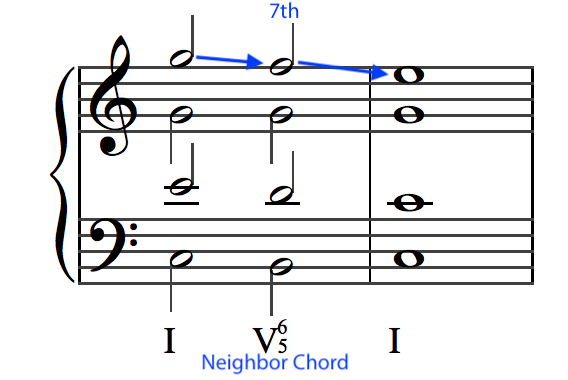DOMINANT AND LEADING TONE SEVENTH CHORDS
This page is a supplement to The Complete Musician: Chapter 8 - More Contrapuntal Expansions: Inversions of V⁷, Introduction to Leading-Tone Seventh Chords, and Reduction and Elaboration
INVERSIONS OF V⁷
The most common seventh chord in Western Classical music is the V⁷ (dominant five seven). Its chord tones are scale degrees 5 - 7 - 2 - 4 in the tonic key. In root position, this chord is very strong and energized and usually signals a cadence point. The three inversions, however (V⁶⁵, V⁴³, and V⁴²) can all be found in tonic and dominant areas of phrases and serve to expand the harmonic length of a phrase.
V⁷ VOICE LEADING RECAP
Inversions of V⁷ should be placed on weaker beats between stronger triads
Spell inversions with all four chord tones
Resolve the chord tones by half steps where possible and keep common tones (presuming that the V⁷ chord is moving to a I chord, 4 should always lead to 3 and 7 should lead to 1 … but 7 in an inner voice can lead to 5)
Generally, either the V⁷ or the chord proceeding or following will be an incomplete voicing or have an unusual doubling to accommodate the rules above.
V⁶⁵ CHORDS
PASSING SEVENTH
The chordal 7th of V⁷ (scale degree 4) moves from 5 - 4 - 3 while the chordal third (scale degree 7) operates as a neighbor movement in the bass.
NEIGHBORING SEVENTH
In this example, the bass stays the same and the chordal 7th of V⁷ moves from 3 - 4 - 3. Notice that the surrounding chords are identical, not revoiced.
V⁴³ CHORDS
PASSING SEVENTH
Here, the chordal 7th (scale degree 4) moves from 5 - 4 - 3 while the chordal 5th (scale degree 2) operates as a passing movement in the bass. The bass and 7th voices move in parallel 10ths.
Neighbor Seventh
In this example, the chordal 7th moves in a neighbor motion from 3 - 4 - 3 while the movement of the tonic bass moves up to the chordal 5th in a neighbor motion in the same direction.
V⁴² CHORDS
Because the chordal seventh (scale degree 4) is in the bass, it is the most unstable inversion. It is often used as an intermediary between arpeggiations of a I chord (like inserting between root position and first inversion), however, when this happens without any non chord tones or other chordal leaps, in the bass, it serves as an incomplete neighbor between 1 and 3. With the use of a V⁴² chord, you will often see additional melodic notes in the bass such as the 5 to create passing motion from 5 - 4 - 3.
INVERSIONS OF viiᵒ⁷ AND viiø⁷
The seventh chord built of the leading tone is usually half-diminished in major (B - D - F - A in C Major) or fully diminished in [harmonic] minor (B - D - F - A♭ in C Harmonic Minor). Because of the more dissonant quality of these seventh chord types and the root being the leading tone, these two chords are much less stable than the more prevalent V⁷ chords reviewed above. The scale degrees in these chords are the 7 - 2 - 4 - 6. Notice that this chord shares almost all the same tones as the V⁷ chord (5 - 7 - 2 - 4) but replaces the 5 with a 6. With the presence of the leading tone 7 and a 6 rather than 5, the viiᵒ⁷ has no chord tones in common with tonic (1 - 3 - 5), which makes it the most dissonant of all diatonic chords.
viiᵒ⁷ VOICE LEADING RECAP
7 always resolves up to 1 by half step
2 moves down to 1 or up to 3 (when moving up to 3, this often builds a chord with a doubled 3rd)
4 resolves down to 3 by half step
6 moves down to 5 (when it is a ♭6 in the viiᵒ⁷, this is a resolution by a half step) - 6 should also be approached stepwise or by common tone
While all of the examples above show the fully diminished seventh chord in practice, they are interchangeable with the half-diminished seventh chord which only has a lowered 7th rather than a double-lowered seventh. Even though half-diminished seventh chords occur naturally as the leading tone seventh chord in a diatonic major, they are infrequently used. Instead, most composers chose, in earlier eras, to swap it out for the fully diminished viiᵒ⁷ because this chord has even more tension in its quality. The act of “borrowing” a chord that exists in another tonality (like borrowing the viiᵒ⁷ from minor and using it in major) is called borrowed chords or modal mixture and will be discussed in depth in Theory IV.










